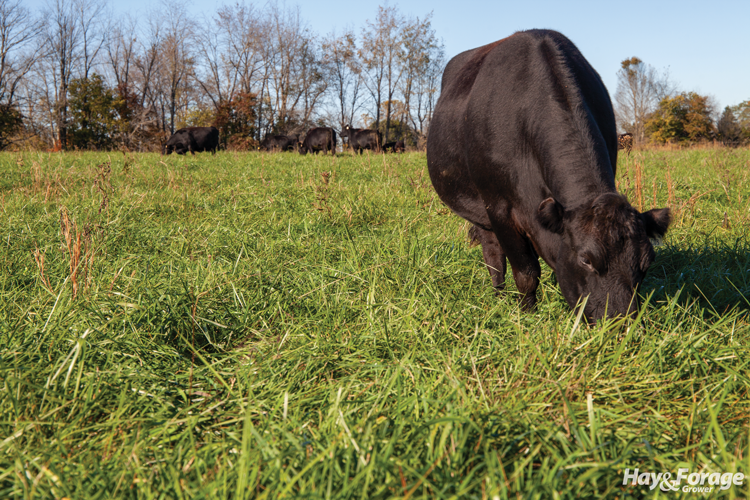All fescue is not created equal |
| By Jim Gerrish |
|
|
 With the end of summer just around the corner, it’s time to plan which pastures or fields you will target to stockpile for winter grazing. While any pasture can be stockpiled, the species composition of the pasture is an important consideration. Some forages tolerate fall and winter weather much better than other species. Tall fescue is one of the standout species. It has been said many times over that tall fescue is the best cool-season grass species for stockpiling. Broadly speaking, that is still true, but we need to sort through some of the details. For many years, I have said there are five good reasons for growing tall fescue for stockpiling. Those five reasons are November, December, January, February, and March. In areas where tall fescue is well adapted to the environment, it will make more fall growth than any other grass species, and the energy and protein content of that forage will be higher than any other grass. Tall fescue yield and quality is also quite durable deep into the winter months. All of this is well established with research throughout fescue-adapted regions over the last 75 years. It’s a new day The new consideration is that today’s tall fescue is not the same as your grandpa’s tall fescue. For the first 30 to 40 years of tall fescue use, the mainstay of all fescue pastures was the endophyte-infected Kentucky-31 (Ky31) variety. All of the horror stories and bad experiences associated with tall fescue over the early years was due to the toxin-producing fungus growing within the plant. These days, we have endophyte-free varieties, novel endophyte (nontoxic) varieties, and soft-leaf varieties with much higher palatability compared to the old Ky31 variety. We also have meadow fescue, a different species from tall fescue, that stockpiles almost as well but has no endophyte issues. Perennial ryegrass has also been crossed with both tall and meadow fescue to give us festulolium, an equally productive and more palatable alternative to tall fescue. The unwarranted fear of the word “fescue” in many regions hampers the opportunity for graziers to dramatically extend the length of their grazing season beyond traditional constraints. As winters have become milder over the last few decades, tall fescue adaptation has been creeping northward. While many livestock producers and their advisers have been hesitant to accept this new reality, many others have embraced the opportunities for extended grazing seasons provided by the new fescue variants. Location, location, location I frequently get asked about how the different types of fescues compare for stockpiling. Here is a quick summary. Most endophyte-free varieties have a hard time persisting south of Interstate 70. North of Interstate 80, survival of endophyte-free varieties has been good all the way up into Ontario and Quebec. Between those two interstates, persistence of endophyte-free fescue depends entirely on the management applied. Persistence is generally better with time-controlled grazing compared to set stocking. With appropriate grazing and nutrient management, stockpiling characteristics are near identical to old Ky31. Novel-endophyte varieties persist much better south of I-70 than do the endophyte-free varieties. They stockpile successfully and provide a solid foundation for winter grazing through much of the South and lower parts of the Midwest. Novel-endophyte varieties can be seeded in Northern regions as well, but they may not be necessary since the typically lower cost endophyte-free varieties perform well in the North. The old Ky31 variety is a stiff-leaf variety and is known to have palatability issues. Soft-leaf varieties are much more palatable than the stiff-leaf types. There are soft-leaf varieties available in both endophyte-free and novel endophyte varieties. For the most part, soft-leaf varieties do not stockpile as well as the stiff-leaf types and are subject to more rapid winter deterioration; however, they are still superior to orchardgrass, smooth bromegrass, or timothy. Meadow fescue competes Most trials that have done side-by-side comparisons of tall fescue and meadow fescue in stockpile situations find them fairly close in most characteristics. Given that both species have a wide range in the cultivars within the species, we could take the very best performing meadow fescue variety and compare it to one of the least desirable tall fescue varieties and make the claim that meadow fescue is actually superior. The flip side is we could take the worst meadow fescue and compare it to the best tall fescue and make the claim that meadow fescue doesn’t begin to compare to tall fescue for stockpiling. If we look at the comparison of meadow and tall fescue across the range of environments and varieties, meadow fescue stacks up extremely well. This article appeared in the August/September 2024 issue of Hay & Forage Grower on page 22. Not a subscriber?Click to get the print magazine. |
